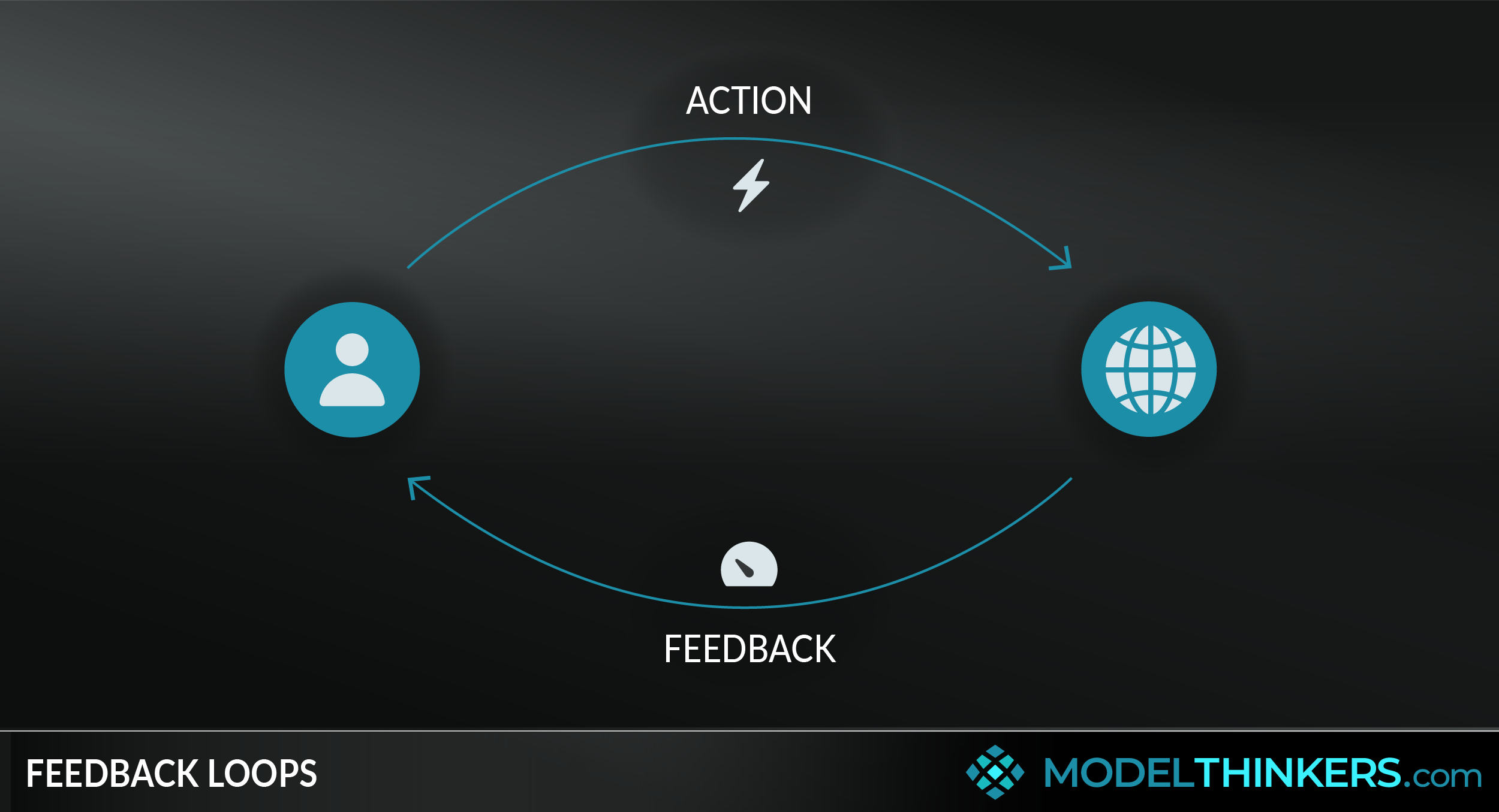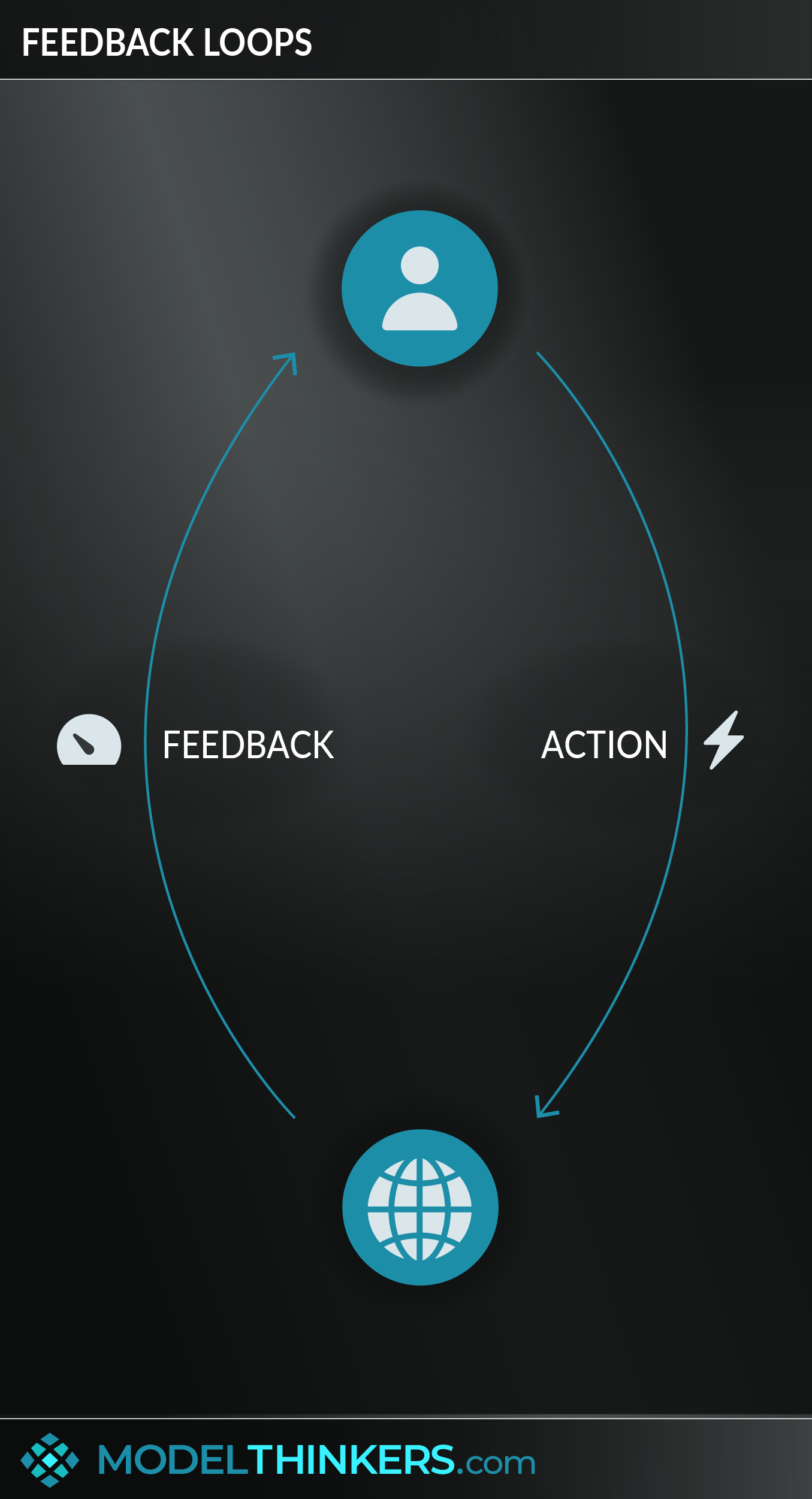

 0 saved
0 saved
 20.2K views
20.2K views








Imagine walking through a fully furnished room, with your arms tied behind your back, wearing a blindfold and noise-cancelling headphones. That would be a painful lesson in the importance of feedback loops in guiding action.
Feedback Loops provide quick information on the impact of actions which can be used to maintain a system (Homeostasis) or to quickly learn, iterate and improve.
BIOLOGY AND HOMEOSTASIS.
In biological terms, Feedback Loops relate to homeostasis, which is a system’s tendency to resist change and maintain relatively constant conditions in its internal environment despite changes to external conditions. Homeostatic control mechanisms use positive and negative feedback loops that change the variable back to its original, ideal value.
SUPPORTING CHANGE.
In contrast, establishing Feedback Loops for behaviour enables you to improve it. This might include providing stakeholders with the means to provide instant feedback on an app, using data-driven dashboards for key business metrics, or simply using a wearable to provide feedback on your daily activity. See the In Practice example of habits and toothpaste below.
To be effective, Feedback Loops would ideally focus on metrics that matter, have minimal lag-time between action and information, and be automated and ongoing.
IN YOUR LATTICEWORK.
This is one of those deceptively simple but incredibly powerful models that will keep popping up everywhere. It's hiding behind Agile Methodology, is inspired by the Scientific Method, and even central to Deliberate Practice which helps develop complex skills.
In addition, you'll see Feedback Loops in Double Loop Learning and Black Box Thinking, for continual improvement.




- Establish Feedback Loops for continuous improvement
Identify potential feedback loops when aiming to improve performance, develop skills, or make a change. Providing expert feedback and/or data-driven metrics provides a ‘reality check’ as to what is working, not working, and how you should adjust as a result.
- Use dashboards
In a business, product launch or any initiative - consider which metrics matter and will inform future decisions. Aim to automatically capture such metrics via a visual dashboard that can be quickly understood and responded to.
- Look for explanations inside the system
Negative feedback loops originate from the system itself or in other words, the output reenters the system as another input. This means that the problems you are dealing with may be caused by your own actions and not by external factors.
- Consider positive and negative feedback loops.
Identify your current feedback loops. Positive feedback loops enable you to create more by adding more value to your strengths, while negative feedback loops encourage you to work on efficiency rather than innovating. Consider which are helping you improve and which ones you can get rid of or pay less attention to.
A major challenge of Feedback Loops is identifying the most powerful data points to include as well as creating systems that can deliver them fast enough to remain relevant. A related issue with feedback loops is when they require a manual process and/ or do not have a clear benchmark as a comparison.
Extreme business success is harder to achieve when focusing exclusively on negative feedback loops. Positive feedback can provide a major advantage and is the secret to capturing a large part of the market. Efforts to achieve homeostasis are more effective when your goal is to maintain a successful position.
The challenge is to find a balance between exploiting what you have (negative feedback) and exploring for new opportunities (positive feedback) at the same time.
The thermostat.
A thermostat includes a thermometer to measure temperature (a feedback loop) and turns the heating system down when the temperature exceeds a certain value (homeostasis). The heat is again turned on when the temperature has dropped below the set threshold.
Habit formation and toothpaste.
In the Power of Habit, Charles Duhigg describes the story of Claude Hopkins. A prominent US businessman in the early 1900s, Hopkins ran an advertising campaign for a new product — Pepsodent, a minty toothpaste.
Rather than a long term gain of tooth care, Hopkins organised a marketing campaign that encouraged people to “just run your tongue across your teeth” to feel the ‘plaque film’ there. This immediate feedback loop helped drive up uptake and sales of his product.
Childbirth.
Childbirth utilises positive feedback loops. The baby’s growth takes up space in a woman’s uterus which stretches the uterine wall and activates receptors there. This signals the woman’s brain to release oxytocin, which causes contractions — or the uterine muscles to contract. This loop continues until the baby is born.
When applied beyond their biological origins,feedback loops provide opportunities for quick learning and iteration.
Use the following examples of connected and complementary models to weave feedback loops into your broader latticework of mental models. Alternatively, discover your own connections by exploring the category list above.
Connected models:
- Deliberate practice: this model requires a feedback loop for the development of complex skills.
- The scientific model: in a sense, the scientific model could be viewed as a series of feedback loops based on developing hypotheses and testing them.
Complementary models:
- Balanced scorecard: use feedback loops to inform a dashboard with these metrics.
- Inversion: use this model for an alternative view on which metrics measure, particularly in avoiding failure.
- Systems vs goals and habit formation: consider embedding feedback loops into daily systems.
- Overton window: in consideration of what and how are societal views changing.
Feedback loops were first referenced in biology, in relation to homeostasis, where bodies maintain equilibrium by using a system of feedback controls to ensure their proper functioning.
Read James Clear on Feedback Loops for a more in-depth and practical approach to using Feedback Loops to impact your habits and behaviour.
 My Notes
My Notes
Oops, That’s Members’ Only!
Fortunately, it only costs US$5/month to Join ModelThinkers and access everything so that you can rapidly discover, learn, and apply the world’s most powerful ideas.
ModelThinkers membership at a glance:






“Yeah, we hate pop ups too. But we wanted to let you know that, with ModelThinkers, we’re making it easier for you to adapt, innovate and create value. We hope you’ll join us and the growing community of ModelThinkers today.”




















































































